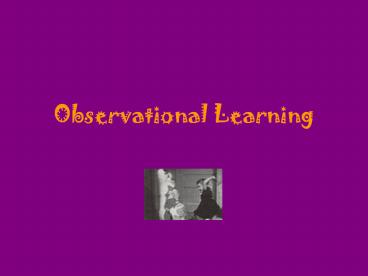Observational Learning - PowerPoint PPT Presentation
1 / 10
Title:
Observational Learning
Description:
Compared with children NOT exposed to the adult model, those who observed the adult model s aggressive outburst were much more likely to lash out at the doll. – PowerPoint PPT presentation
Number of Views:80
Avg rating:3.0/5.0
Title: Observational Learning
1
Observational Learning
2
Learning occurs not only by conditioning but by
observing others
3
- Observational learning? learning by observing
others and imitating their behavior - Modeling? the process of observing and imitating
a specific behavior - Monkey see, monkey do
- Humans have a strong tendency to imitate
behavior. - Memes? transmitted cultural elements such as
ideas, fashions, and habits that travel by
imitation
4
- Mirror Neurons? provide a neural basis for
observational learning? frontal lobe neurons that
fire when performing certain actions or when
observing another doing so - The brains mirroring of anothers actions may
enable imitation, language learning and empathy - Ex.- We find it harder to frown when viewing a
smile than when viewing a frown.
5
Banduras experiment
- Preschool children observed adults beating a Bobo
doll- Adults were pounding, kicking, and throwing
a large inflated Bobo doll around the room, while
yelling such remarks as, Sock him in the nose
Hit him down Kick him. - Children were later given the opportunity to play
with the Bobo doll. Compared with children NOT
exposed to the adult model, those who observed
the adult models aggressive outburst were much
more likely to lash out at the doll. Children
imitated the very acts they had observed and used
the words they heard.
6
(No Transcript)
7
- What determines whether we will imitate a model?
- Reinforcements and punishments? We learn to
anticipate a behaviors consequences in
situations like those we are observing. - We are especially likely to imitate those we
perceive as similar to ourselves - We imitate those that are successful.
- We imitate people we admire.
8
Applications of Observational Learning
- Antisocial models- in ones family or
neighborhood, or on TV- may have antisocial
effects. - Copycat threats or incidents in every state
after Columbine High School massacre - Abusive parents might have aggressive children
- Many men who beat their wives had wife-battering
fathers - Intergenerational transmission of abuse or
violence
9
- Positive behavior can also be learned through
observational learning. - Prosocial (positive, helpful, constructive)
models can have prosocial behavior. - People who exemplify nonviolent, helpful behavior
can prompt similar behavior in others - Martin Luther King, Jr. made non-violent action a
powerful force of social change through modeling
10
Models are most effective when their actions
and words are consistent.































